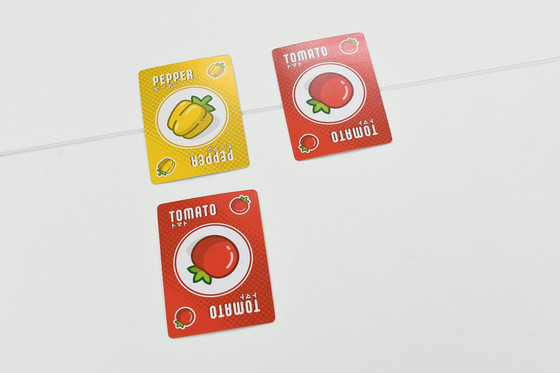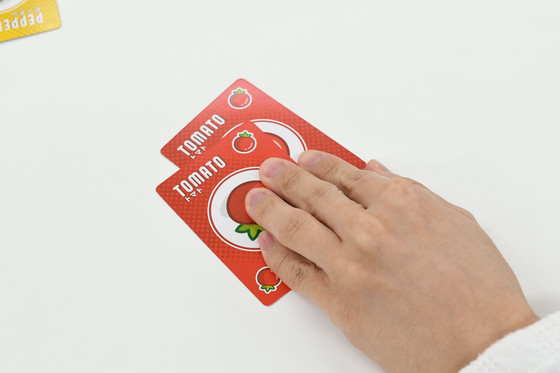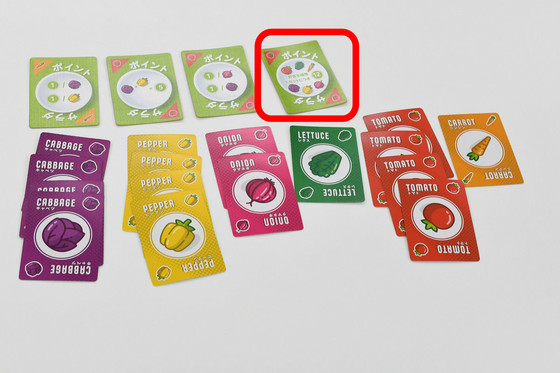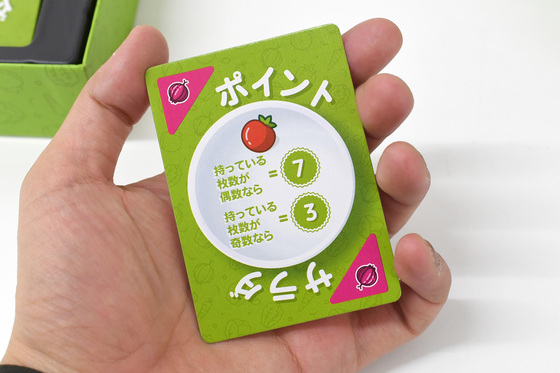Play review of the card game 'Point Salad' that collects 6 kinds of vegetables to make a higher-scoring salad

Arclight Games has released a complete Japanese version of the card game 'Point Salad ' that aims for high scores with that skill while collecting 6 kinds of vegetables such as tomatoes and cabbage. 'Adults and children, handy and fun card game' yet,
Point Salad Complete Japanese Version | ArclightGames Official
https://arclightgames.jp/product/%E3%83%9D%E3%82%A4%E3%83%B3%E3%83%88%E3%82%B5%E3%83%A9%E3%83 % 80 /
The point salad package looks like this.

The target age is 12 years old and over, the play time is 15 to 30 minutes, and the number of players is assumed to be 2 to 6. This time I will play with 6 people.

The contents are a manual and 108 cards. The card is a double-sided type, one is the 'vegetable side' on which vegetables are drawn, and the other is the 'point side' on which the conditions for score calculation are drawn.

There are 6 kinds of vegetables: tomato, onion, lettuce, peppers, cabbage and carrot.

Shuffle the cards with the points side up, divide them into roughly three equal parts, and prepare three decks.

Then, arrange a total of 6 cards, 2 vertically from each deck, with the vegetable side facing up as shown in the image below. The game is now ready.

The rules are very simple. Players can draw cards in their turn. Do you draw one card from the three points on the top of the deck?

There are two ways to choose and draw two from the six vegetable-faced cards that have been released. If you draw a card on the vegetable side, replenish it from the deck in the same row.

Keep the points and vegetables you got at hand. The point side shows the conditions for calculating points based on the vegetable side card at the end of the game. For example, on the left side of the following point cards, the condition is 'Get 8 points for each set of cabbage, carrots and tomatoes'. Looking at the vegetable side card, I got 2 each, so at this point I have already secured 16 points.

Also, if it's your turn, turn over one point card ...

You can also change it to a vegetable card. What kind of vegetables will be turned over is described in the corner of the point surface. However, the vegetable side card cannot be used as the point side.

With that kind of feeling, play while turning the turn in order, and the game ends when both the deck and the vegetable side are gone.

The player who was collecting cards by squeezing tomatoes, cabbage and carrots looks like this. With the card '5 points for each type of vegetables you don't have', you can expect 3 types x 5 points = 15 points at this point.

However, it is one turn before the player, and there are 3 vegetables left. One of the three is a bell pepper card that the player does not have.

And, as a matter of course, the player in the foreground brought two tomatoes ...

I had to draw the last one of the peppers. As a result, the number of 'vegetables I don't have' has decreased, and my score has decreased by 5 points. Still, the total score is 1 set of cabbage, carrots and tomatoes 8 points x 4 + (1 tomato 2 points x 5 + 1 carrot 1 point x 4) + 1 kind of vegetables you don't have 5 points x 2 + 2 tomatoes 5 points x 2 = 66 points, which is not bad.

On the other hand, the player who had two tomatoes in the foreground had a card that said, 'If you have one set of all kinds of vegetables, you get 12 points.' I stayed.

The first place was the player who focused on lettuce and accumulated points, with 73 points.

So, in another game, the player who thought, 'Isn't it possible to aim for a high score by narrowing down the vegetables to be collected?' execution. As a result, we succeeded in hitting a high score of 105 points. It is possible to aim for a high score by making full use of a combo that combines multiple point faces according to the vegetables, rather than just collecting vegetables.

The rules are very simple and easy to understand, and one game can be played by 6 players in about 20 to 30 minutes, and it goes smoothly. Due to the system of the game, there is almost no obstruction to others, and it is a play that accumulates points firmly while looking at your own hands and the cards in the field, so there is no scene where the place gets excited greatly, but I collected it. The impression when vegetables produce a huge number of points from multiple points is considerable. However, if multiple point planes are involved, the score calculation will be a little complicated, so it is recommended to prepare a memo or calculator.
By the way, does the card 'If ... is an even number' include 0 cards? That was a discussion during the actual play. Considering that it is a mathematical common sense that '

The full Japanese version of Point Salad is available on Amazon.co.jp and can be purchased for 2336 yen at the time of writing the article.
Amazon | Arclight Point Salad Complete Japanese Version | Board Games | Toys

Related Posts:







